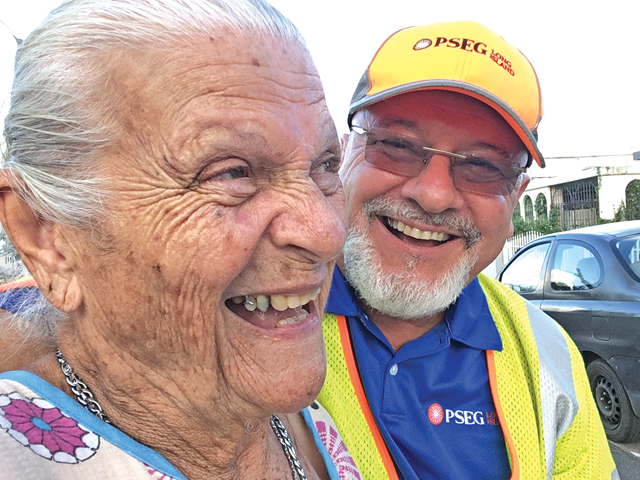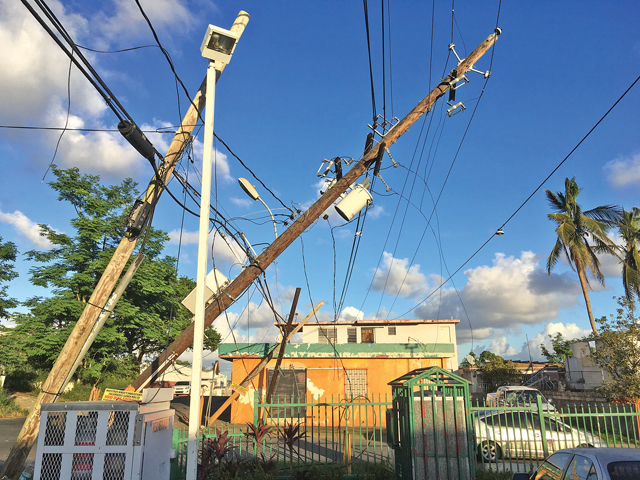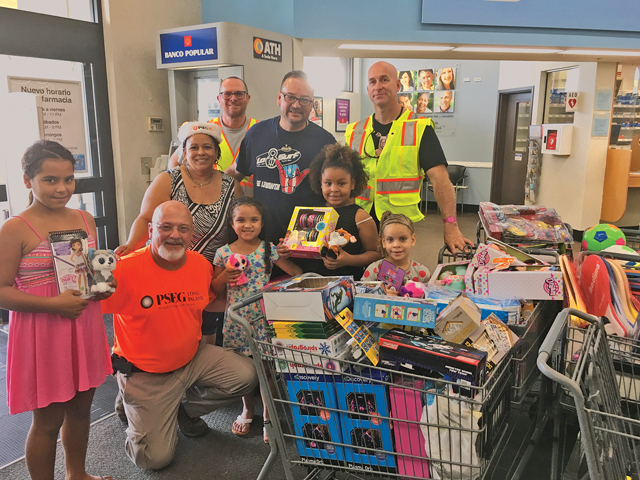‘A lot of tears’: Local PSEG worker recalls month in Puerto Rico


Hurricane Maria made landfall on Puerto Rico on Sept. 20, 2017. The Category 4 storm, with winds of 155 miles per hour, tore through the Caribbean island, devastating homes and destroying infrastructure, including wiping out its electrical grid.
Concrete, rebar-reinforced utility poles that stood 70 feet tall were snapped in half — some pierced the roofs of homes and housing developments. Some neighborhoods had six, seven, eight poles down in a row. Transformers were tossed into backyards and swimming pools, according to Ray Homburger of Wading River, a PSEG Long Island employee who recently returned from a trip to help with restoration efforts there.
To him, those were “holy cow” moments that he captured in photos.
“It was an eye-opener. It was exhausting and it was emotional,” said Mr. Homburger, 61.
In early October the New York Power Authority asked for volunteers to do damage assessment and Mr. Homburger was one of dozens who signed up. He learned he was going to Puerto Rico about two weeks before departing; it was the first trip of its kind he’s been on. He was there from Dec. 12 to Jan. 8.
Mr. Homburger was tasked with going from circuit to circuit in the San Juan vicinity — as well as in Caguas, a high, hilly region south of the capital city — taking detailed notes and GPS-marked photos of every damaged location. Volunteers put together a list of the equipment needed to restore normal operations so that utility crews, whose bucket truck had to be brought in by barge, could replace the mangled hardware.
The PSEG crews were putting in 16-hour days, seven days a week. Mr. Homburger and his fellow volunteers would walk four to seven miles each day, following the circuits in what he described as “super hot, humid conditions,” across varying terrain.
One day they’d be walking through tight quarters amid high-rise buildings and another they’d be on the hillsides with heavy tropical foliage.

Getting around the island wasn’t easy. With no electricity, traffic lights were out, making intersections challenging. And it would rain, heavily, in the afternoon, causing mudslides that blocked roadways because the plants that typically held the ground firm had been blown away.
“One day a trip would take you two hours, then next day the same general area would take you 3 1/2 hours,” Mr. Homburger said.
While the work was physically exhausting, it was also rewarding, he said, especially seeing the how the people of Puerto Rico reacted to the presence of volunteer utility crews.
“I have to say the people of Puerto Rico are phenomenally resilient and they’re gracious,” Mr. Homburger said. “There was not a negative word spoken to any of the folks that I worked with in the month that I was there. And they were thankful.”
Routinely, people would stop their cars in the lane they were traveling, roll down their windows and thank the crews for being there and not forgetting about them.
Mr. Homburger, who works in customer quality assurance, has worked in the power realm nearly 38 years. He started out in operations at the Shoreham nuclear power plant and later taught employees of PSEG’s predecessor companies how to restore power on transmission and distribution systems. He was also responsible for major customers such as Brookhaven National Lab.
The damage in Puerto Rico is going to take quite a long time to clean up, Mr. Homburger said. Almost five months after the hurricane, power on the island has still not been fully restored.

Without electricity, and therefore without working phones lines, it was difficult for families to connect with their loved ones in the hurricane’s aftermath. One Long Island family had not heard from an elderly relative and asked if the PSEG crew could check up on her. They found her on their third day there and sent a photo with her to let her family know she was safe.
“There were a lot of tears involved,” Mr. Homburger said. “I have to tell you there were frequently tears when you were hugging customers in the street, trying to reassure them we were doing everything we can to help them.”
The PSEG crews had an impact in other ways, too. Mr. Homburger and other volunteers, who were on duty over the holidays, arranged to give out toys to children during a Three Kings Day parade, an important local holiday.
“The people were wonderful and thankful and here are folks that in many cases have lost their homes, they’re sharing a residence with neighbors or friends, if they had family nearby and they have nothing and yet they’re coming out and offering us water,” he said. “And on Christmas and New Year’s, offering us food when we were by homes around lunchtime. It really tugged at your heartstrings to see that.”
Mr. Homburger was away not only for Christmas, but also during a window that included both his wife’s and his daughter’s birthdays.
His wife, Cathy, admitted it was bittersweet at first. She and their daughter, Nicole, 34, had a “little Charlie Brown Christmas,” but ultimately, they realized the volunteer trip was something he really wanted to do. Ms. Homburger noted that her husband has always been giving and is involved in local charities at home.
“I think he really made a difference,” she said.
Mr. Homburger said he’d volunteer for another trip, should the need arise.
“I think it’s important to note that PSEG Long Island and Long Islanders in general are often the recipients of other utilities helping us out during storms, so it really felt great to be able to return that generosity to our neighbors in Puerto Rico,” he said.
Top Caption: Ray Homburger with the woman he helped reconnect with a Plainview family after they could not reach her following Hurricane Maria. (Credit: Ray Homburger)








